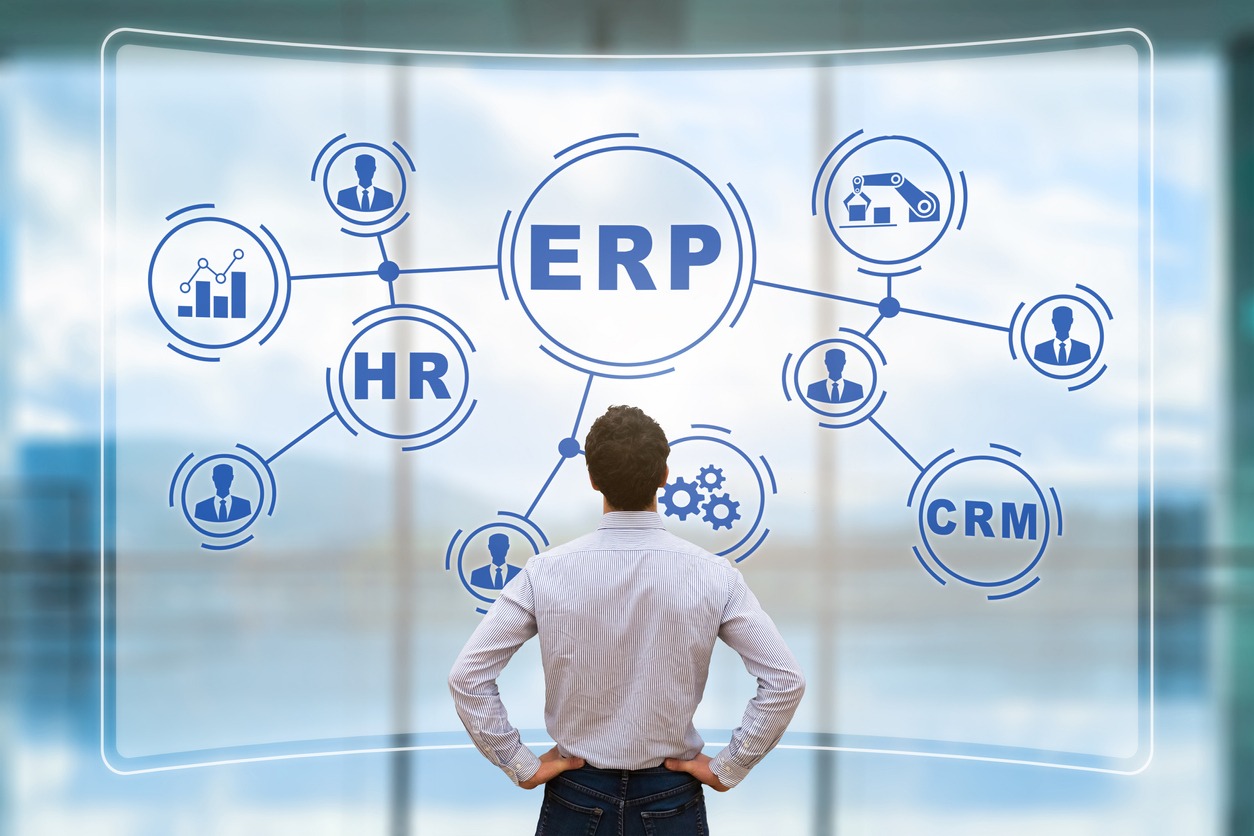Modern Enterprise Resource Planning systems (ERPs) are designed to serve as a single source of truth for the entire organization, offering numerous benefits including standardized data, better visibility and collaboration, organized workflows, real-time reporting and increased operational efficiency. Not so long ago, ERPs were considered a software reserved for enterprises and large businesses because of high upfront costs and other barriers to entry. Things have changed in the past two decades and now even SMBs can take advantage of modern cloud computing technologies.
What is a SaaS ERP System?
A SaaS ERP system is a centralized system that allows businesses to manage and integrate many business functions and processes. Depending on the business and the solution, an ERP can connect a variety of business functions including:
- Finance
- Human Resources
- Sales
- Supply Chain
- Manufacturing
- Customer services (CRM)
- Inventory Management
- Order processing
- Resource planning
- Procurement
- Production planning
ERPs are comprehensive solutions that include many apps and modules designed to work together seamlessly. ERPs provide businesses with a single platform to streamline operations and improve efficiency while facilitating decision making based on real data. The primary goal of using an ERP system is to have consolidated data from different departments. It serves as a unified database designed around a well-defined schema (data structure).
All the modules have access to the same data, which is based on the same user experiences and common definitions. ERPs are like a vehicle for connecting processes, workflows, people and technologies across an organization and have different characteristics.
For example, consider an automobile business that has to procure a wide range of parts from different suppliers. It has to track requisition and purchase of these parts, which involves multiple departments including procurements, sales, supply chain etc. By using an ERP system, businesses can ensure that the data is clean and uniform across all business processes. ERPs enable the business to collect, analyze, organize and distribute this unified information to all team members, allowing them to carry out their tasks more efficiently.
Since ERPs have to cater to the needs of a diverse range of businesses, most ERPs are modular in nature. This allows businesses to choose modules they need and customize each according to the industry requirements and their own unique needs. We have covered some of the best SaaS ERP solutions and the best cloud-based ERP services in dedicated posts, which includes ERPs for both large businesses and SMBs.
Benefits of Using a SaaS ERP System
SaaS ERP solutions offer almost the same benefits and present similar challenges as other SaaS solutions. Buying an ERP solution can be an overwhelming decision, so businesses need to carefully evaluate both the benefits and challenges when going all in. Sure, running a business is possible even without an ERP, but today’s demanding marketplace requires businesses to remain one step ahead of the competition and seize every opportunity. Following are some of the key reasons why both enterprises and SMBs should consider investing in an ERP system.
Gives Businesses a Competitive Advantage
Although buying a SaaS ERP solution can be a significant investment, the cost of not buying one can be greater in the long run in today’s ultra-competitive business environment. ERPs minimize data duplicity and inaccuracies, boost productivity, and can save businesses from making costly mistakes. An ERP serves as an extra brain that gives businesses an edge over the competition by increasing productivity and keeping everyone on the same page.
Cost Savings
A single source of accurate and up-to-date information can help businesses save time and human resources, which can be utilized more efficiently on core tasks. Proactive management helps prevent disruptions and enable team members to make timely and data-driven decisions. The ROI of using an ERP can be significant provided a business has chosen the right vendor and the right solution according to their needs and business objectives.
Data Reliability and Consistency
SaaS ERPs provide all departments and employees with access to the same, real-time and accurate data, which is accessible from anywhere, using almost any device. This ensures that they can use it without the fear of running into risk of duplication, inaccuracies and errors. ERPs from reputable vendors come with robust security, which prevents confidential business information from getting into the hands of unauthorized users.
Accurate, Data-driven Forecasting
ERPs empower businesses to create accurate forecasts based on real-time data. It gives a bigger and a clearer picture of the business, enabling the management to think and plan proactively. It improves forecasting through integrated data, advanced analytics and reporting, historical data analysis, input from stakeholders and other channels, allowing businesses to evaluate different business scenarios, track forecasts and plan demand.
Task Automation and Improved Process Efficiency
By minimizing repetitive processes and reducing manual data entry through automation, ERPs improve user productivity and data accuracy. Tasks like order processing, invoice generation, data entry and manual inventory management can take a lot of time and effort. Higher process efficiency and productivity can be achieved by automating these repetitive and routing tasks, while eliminating human error and accelerating process execution at the same time.
Improves Interdepartmental Collaboration
ERPs help connect different departments and provide them with the same information in real-time, which is a big jump from spreadsheets and traditional databases in terms of efficiency and collaboration. Most modern SaaS ERPs include tools that facilitate effective communication and collaboration between departments and employees. Examples of these tools include discussion boards, document sharing, chat functionality and task management.
A unified collaboration platform enables businesses to minimize reliance on conventional communication channels such as emails and phone calls, ultimately boosting productivity. Other benefits of using an ERP in the context of collaboration include streamlined approval processes, transparency, cross-functional reporting and analytics, and enhanced supplier/customer interactions.
Highly Scalable
SaaS ERP solutions are highly scalable and offer a lot of flexibility. Businesses can add new modules, users and functions as they grow. The system grows with the business and facilitates expansion and seasonal spikes without disruptions. ERPs allow businesses to scale up or down based on demand and usage without having to make significant investments in infrastructure and maintenance.
Reduced Dependence of Third Parties
By using one solution for multiple processes and business functions, businesses can save themselves from having to deal with a whole bunch of software vendors. ERPs can offer similar or better results than using multiple solutions by eliminating the pain of data duplication and operational inefficiencies associated with using multiple solutions.
Centralized, Unified Information
Modern SaaS ERP systems consolidate data from different systems and processes into a unified platform by integrating data from various departments. The single source of truth eliminates data duplication and human error and provides all team members with access to the same data in real-time. Centralized information also enables the workforce to access data from anywhere, using almost any device, which has become a necessity for today’s mobile workforce.
A unified platform also helps streamline workflows, improve communication and collaboration and provides robust reporting and analytics across various business dimensions. This makes it easier for the management to gain valuable insights into KPIs, make data-driven decisions, identify trends and promote a culture of continuous improvement while ensuring compliance.
Customized Reporting
Modern ERPs are able to handle complex data requests with ease, making reporting more customizable and easier. This significantly reduces wait times between data requests and decision making. It allows users to generate reports without having to rely on the IT staff, saving time and improving productivity. Real-time and comprehensive insights into the financials, inventory, production and other critical metrics and KPIs allow the management to make timely and data-driven decisions based on factual information instead of guesses.
Modern SaaS ERPs include customizable dashboards, data visualization tools, Ad Hoc reporting, drill-down capabilities, predictive and prescriptive analytics, performance monitoring alerts and more, empowering businesses with powerful tools to stay competitive and boost productivity.
Compliance
One often underrated benefit of using a modern ERP system is its ability to tie into industry-specific regulatory compliance. Since these systems automatically keep track of regulations and compliance standards, businesses don’t have to worry about implementing and monitoring everything themselves.
Compliance with internal governance policies and external regulatory requirements improves data security, makes tracking, auditing and generating compliance reports easier. Automated alerts can be set up for deadlines and compliance requirements, reducing risks of non-compliance and ensuring that businesses are meeting compliance requirements.
Improves Customer Service
Effective customer data management, streamlined inventory and order management, accurate and quick invoicing, enhanced communication, and integrated customer support are only some of the ways ERPs can help improve customer experience. Functionalities like customer self-service portals make it easier for customers to manage their own accounts and perform a variety of tasks such as order tracking, updating information, and viewing invoices.
Challenges of Implementing a SaaS ERP System

Like other software and tech, there are certain barriers to successful implementation of SaaS ERP solutions. Businesses need to keep both the benefits and challenges of implementing an ERP system in mind to make an informed decision and make the most out of their IT investment.
Complex Implementation Process
The ERP implementation process starts with planning and resource allocation, and includes data migration, configuration and customization, user adoption, testing and quality assurance. Managing all these aspects can be challenging for businesses that lack the technical expertise to implement and monitor at every stage. That’s why they might have to engage implementation consultants or partners who can help them throughout the process and provide comprehensive support and training.
Although implementing SaaS ERPs is a lot less complicated than implementing an on-premises ERP solution, SMBs might still need a certain level of technical know-how for successful implementation of an ERP system. Otherwise, they might have to pay extra fees for vendor support, training, change management and other factors mentioned above.
Upfront and Recurring Costs
Although SaaS solutions generally cost a lot less in terms of upfront costs (compared to using an on-premises solution), things can be a little different when it comes to ERP solutions. These solutions are comprehensive solutions that include different modules and might involve multiple fees. Add implementation and training costs into the equation and an ERP can turn out to be expensive, especially for small and medium businesses.
The cumulative subscription fees can add up to a significant amount over time, especially for organizations with a large user base. Although most ERPs allow a certain level of customization, businesses have to pay extra fees for extensive customization and configuration to tailor the software according to their individual needs. Other costs associated with implementing ERPs may include data integration and migration fees, training and change management, and additional investments in data compliance and security.
Limited Customization Options
Businesses need to carefully evaluate their requirements and available solutions in order to find the perfect ERP solution. Failing to do so may result in businesses trying to make a lot of customization down the road, which can cost time and money. It’s common for ERPs to be designed around predefined workflows, features and configurations in order to be scalable and standardized. This can make it challenging to accommodate highly specialized or complex business processes, so businesses have to adjust their workflows according to the predefined capabilities.
Certain sectors can have unique compliance requirements that call for specific customization. Businesses may have to consider alternative solutions or find workarounds to such ERP systems, which reduces the efficiency modern ERPs promise and defeats their purpose.
Slow Adoption Rates, Change Management and Resistance from Employees
It’s not uncommon to see employees resist adopting to a new system or find it difficult to move from a legacy to a cloud-based ERP system. Their resistance is usually a result of fears or concerns about increased workload, unfamiliarity or even fear of job loss. Businesses need to clearly communicate with their employees and highlight the benefits of using a SaaS ERP system, provide comprehensive training, and address their concerns to overcome slow adoption and resistance.
Data Migration can be Challenging
The challenges related to data migration depend on a variety of factors, including the volume and complexity of data. Businesses have to ensure accuracy, integrity and compatibility of data when migrating vast amounts of data into a SaaS ERP. It can be a challenge for businesses to map large amounts of complex or legacy data structures to the required format. The data may require ‘cleansing’, which can be a time consuming and complex process. Data testing and validation can also take quite some time as businesses need to ensure data integrity and consistency across businesses processes and modules.
Consolidation and integration of data from multiple systems makes the challenge even bigger, especially when data formats are different or when working with disparate systems. Migration may also result in downtimes and disruptions, which can affect routine business operations and ultimately impact productivity and revenue. Then there are security risks including increased risk of unauthorized access or data exposure during migration. Compliance with standardized regulations such as HIPAA and GDPR helps mitigate this risk and adds a protective layer during migration.
Lack of Commitment from the Management
Another big challenge to successful implementation of an ERP system is the lack of commitment from the management and lack of a clear strategic vision. Without support and active involvement from the management, it’s very difficult to align implementation with the strategic objectives of an organization. The management also has to take care of other aspects including, leadership and communication, change management, risk management and resource allocation, and lack of commitment to any of these can pose serious challenges for a successful implementation.
Conclusion
Traditional ERP software used to be costly solutions that required a large IT investment and technical expertise. Thanks to the adoption of cloud-based technologies, businesses no longer have to set up and maintain hardware and software on their own, making ERPs accessible to small and medium businesses. Although the benefits of implementing a SaaS ERP system outweigh the disadvantages, businesses still need to consider the common challenges.
Implementing an ERP system can affect business processes across the board, including changing how people work by replacing old, manual processes. Managing this change requires a strong commitment from the management and the project team. But once successfully implemented, an ERP can be an investment worth it in the long run and provides businesses with a single source of truth everyone can rely on.


